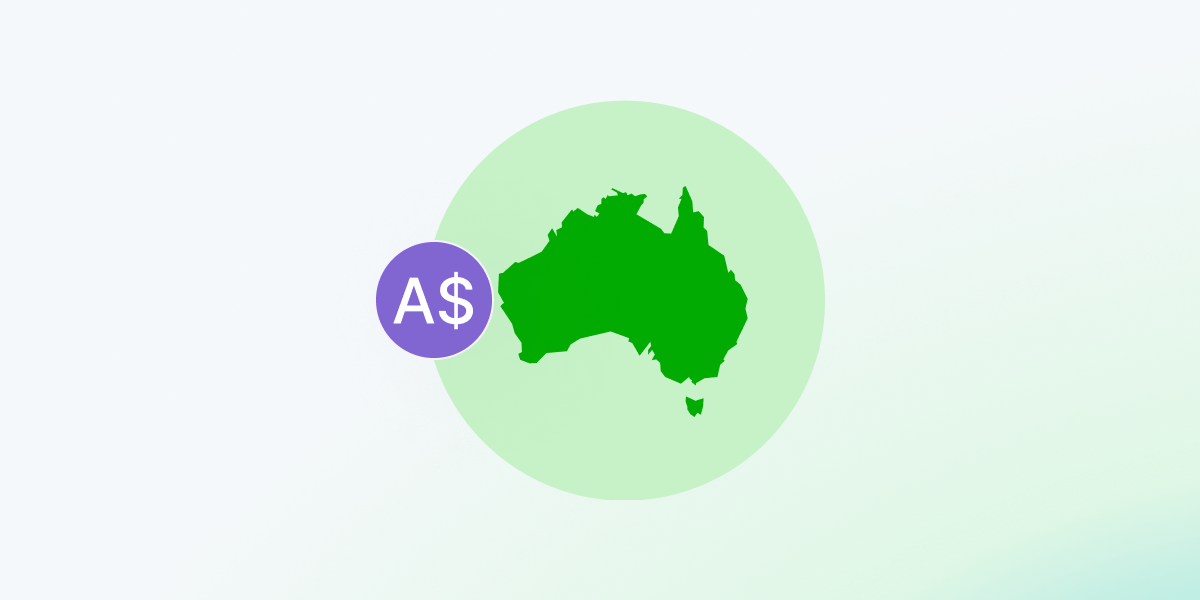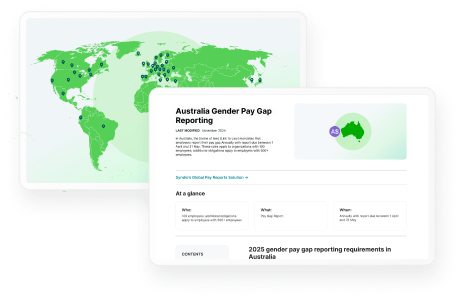In Australia, the Workplace Gender Equality Act 2012 mandates that non-public sector employees with 100 or more employees submit an annual report on gender equality, including pay gaps. The report is due between 1 April and 31 May.
Australia Gender Pay Gap Reporting: What You Need to Know
LAST MODIFIED: October 24, 2025


At a glance
Who:
100 employees; additional obligations apply to employers with 500+ employees
What:
Pay Gap Report
When:
Annually with report due by 31 May
2025 gender pay gap reporting requirements in Australia
When is Australia’s gender pay gap report due?
The gender pay gap report in Australia is due by 31 May. Employers may file the report anytime between 1 April until 31 May.
Who needs to report on pay gaps in Australia?
Any non-public sector employer with 100 or more employees for at least six months of the reporting period must submit a report. Employers who previously registered, but now have fewer than 100 employers, are required to continue reporting until they have employed less than 80 employees for six months or more of a reporting period.
In addition to the standard reporting requirements for employers with 100 or more employees, employers with 500 or more employees are required to have a policy or strategy in place against six Gender Equality Indicators to remain compliant and must meet a Gender Equality Standard.
What pay gap metrics do I need to report in Australia?
The Australian law requires that eligible employers complete a Workplace Profile which collects information about workforce composition, base salaries, and total remuneration, during the relevant 12-month snapshot period.
Employers must also complete an online questionnaire detailing your organisation’s policies, strategies, and actions on gender equality, as well as a Workforce Management Statistics form. The form is designed to collect information about employee movements, including appointments, promotions, resignations, and parental leave. The report must have the sign-off of your CEO, or equivalent.
If you’re a Syndio customer using Global Pay Reports, you’ll receive a detailed data template to help you prepare your report. You can also ask Expertise On Demand, Syndio’s expert AI, for country-specific guidance whenever you need it.
In addition, based on information provided by the employer, the Workplace Gender Equality Agency (WGEA) analyses and publishes the following pay gap figures to the WGEA Employer Data Explorer:
- Median base salary
- Median total remuneration
- Average base salary
- Average total remuneration
Where do I need to share the pay gap report in Australia?
Employers must analyze and publish pay metrics to the WGEA Employer Data Explorer.
Employers must also notify employees, members or shareholders, and employee organisations with members in its workplace that a report has been filed. Employers are also required to advise employers and members or shareholders on how they can access public data and grant this access. Employees and employee organisations should be informed of their ability to comment on the report to the employer or relevant Agency.
After submitting the report, employers are required to provide the Executive Summary and Industry Benchmark Reports generated in the WGEA portal to their board or governing body.
Syndio’s Global Pay Reports help you centralize and automate reporting for 35 jurisdictions across 43 countries, including Australia. Our software makes reporting easy, fast, and accurate so you can report with confidence, even as requirements change. And our services team can answer all your detailed questions — we’re experts so you don’t have to be.
Request a demo of Syndio's Global Pay Reports software.
Employers in Australia and the EU Pay Transparency Directive
Australia’s pay gap laws will not be directly impacted by the EU Pay Transparency Directive. Only the 27 Member States of the European Union are required to adopt the Directive.
That said, the EU Pay Transparency Directive will impact employers headquartered in Australia if they have employees in any EU Member State. Many of the Directive’s pay equity and pay transparency obligations will apply to Australian employers with employees in the EU. Some obligations, like pay gap reporting, will apply to employers with more employees in the EU.
There’s also a growing trend of countries learning from and adopting elements of pay gap reporting laws from around the world so the EU Pay Transparency Directive may be a roadmap for future developments in Australia.
Syndio has you covered as pay equity, pay reporting, and pay transparency demands grow with the EU Pay Transparency Directive. Learn more ->
How Syndio supports compliance with global pay equity, pay reporting, and pay transparency regulations
Syndio provides the technology and expert partnership you need to comply with the growing pay equity, pay reporting, and pay transparency requirements around the globe.
- Report your pay data and pay gaps — with Syndio’s Global Pay Reports. Our software supports fast, easy, and accurate compliance with pay reporting in 35 jurisdictions across 43 countries, including Australia and for the EU Pay Transparency Directive. Syndio also supports the EU’s CSRD reporting.
- Run legally defensible pay audits — with Syndio’s PayEQ. Our suite of solutions give you the tools and compliant methodologies to analyze, explain, and resolve pay and career advancement gaps.
- Pay everyone consistently — with Syndio’s Pay Finder. On-demand pay recommendations help managers and recruiters make fair, consistent pay decisions that don’t exacerbate unlawful disparities.
- Create a customized action plan — with Syndio’s EU Readiness Strategy Package. Syndio’s team of experts help you build a custom strategy and support project management. This includes a change management strategy session for senior leaders, communications strategy session on pay gap and Right to Information, and ongoing support on best practices and trends.
- Craft tailored communications strategies — with Syndio’s Communications Package. Leverage best practices to build a communications plan that builds your brand while aligning to your values and objectives.
Syndio takes data privacy and security seriously. Syndio is GDPR compliant, SOC 2 Type II and ISO 27001 2022 certified, and has completed the Cloud Security Alliance CAIQv.4.02 security self-assessment for STAR Level One. Learn more in our Trust Center under “Security Reports.”
FAQ: The most asked questions about Australia’s gender pay gap reporting
Syndio helps customers all over the world with their global pay reporting needs. Here are some common questions we get about the reporting requirements under Australia’s pay gap law.
The information provided on this resource does not and is not intended to be legal advice. All information, content, and materials are provided for general informational purposes only. The links to third-party or government websites are offered for the convenience of the reader; Syndio is not responsible for the contents on linked pages.
Subscribe
Join our community and stay up to date on pay reporting transparency.
Top pay reporting resources
Syndio’s Global Pay Reports
Learn how Syndio simplifies reporting for 43 countries around the world.
Pay Data Reporting Calculator
Learn where your company must report pay gap data.
